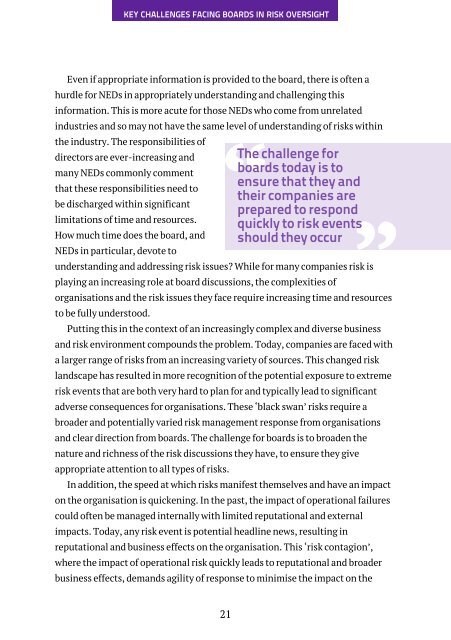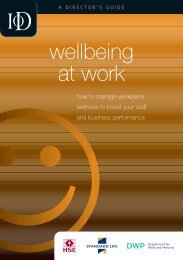Click here to download a pdf - Director Magazine
Click here to download a pdf - Director Magazine
Click here to download a pdf - Director Magazine
You also want an ePaper? Increase the reach of your titles
YUMPU automatically turns print PDFs into web optimized ePapers that Google loves.
KEY CHALLENGES FACING BOARDS IN RISK OVERSIGHTEven if appropriate information is provided <strong>to</strong> the board, t<strong>here</strong> is often ahurdle for NEDs in appropriately understanding and challenging thisinformation. This is more acute for those NEDs who come from unrelatedindustries and so may not have the same level of understanding of risks withinthe industry. The responsibilities ofdirec<strong>to</strong>rs are ever-increasing and The challenge formany NEDs commonly commentboards <strong>to</strong>day is <strong>to</strong>ensure that they andthat these responsibilities need <strong>to</strong>their companies arebe discharged within significantprepared <strong>to</strong> respondlimitations of time and resources.quickly <strong>to</strong> risk eventsHow much time does the board, and should they occurNEDs in particular, devote <strong>to</strong>understanding and addressing risk issues? While for many companies risk isplaying an increasing role at board discussions, the complexities oforganisations and the risk issues they face require increasing time and resources<strong>to</strong> be fully unders<strong>to</strong>od.Putting this in the context of an increasingly complex and diverse businessand risk environment compounds the problem. Today, companies are faced witha larger range of risks from an increasing variety of sources. This changed risklandscape has resulted in more recognition of the potential exposure <strong>to</strong> extremerisk events that are both very hard <strong>to</strong> plan for and typically lead <strong>to</strong> significantadverse consequences for organisations. These ‘black swan’ risks require abroader and potentially varied risk management response from organisationsand clear direction from boards. The challenge for boards is <strong>to</strong> broaden thenature and richness of the risk discussions they have, <strong>to</strong> ensure they giveappropriate attention <strong>to</strong> all types of risks.In addition, the speed at which risks manifest themselves and have an impac<strong>to</strong>n the organisation is quickening. In the past, the impact of operational failurescould often be managed internally with limited reputational and externalimpacts. Today, any risk event is potential headline news, resulting inreputational and business effects on the organisation. This ‘risk contagion’,w<strong>here</strong> the impact of operational risk quickly leads <strong>to</strong> reputational and broaderbusiness effects, demands agility of response <strong>to</strong> minimise the impact on the21









